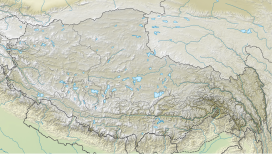| Revision as of 02:23, 16 September 2013 editThe Discoverer (talk | contribs)Extended confirmed users6,241 edits Readding category; discussion mentioned in previous edit summary does not in any way permit removal of category, if the closer wanted he would have remove it himself as he did for another article. Infact that discussion wasn't about article content at all← Previous edit | Revision as of 17:06, 16 September 2013 edit undoZanhe (talk | contribs)Autopatrolled, Extended confirmed users, Pending changes reviewers132,020 edits Self-published sites are not reliable sources per WP:SPSNext edit → | ||
| Line 17: | Line 17: | ||
| The '''Lanak Pass''' or '''Lanak La''' is a mountain pass in ], China. It is on the southeastern boundary of the ] region that is controlled by China but disputed by India. | The '''Lanak Pass''' or '''Lanak La''' is a mountain pass in ], China. It is on the southeastern boundary of the ] region that is controlled by China but disputed by India. | ||
| India regards Lanak Pass as a boundary with China,<ref name="maxwell">{{cite book |title=India's China War |last=Maxwell |first=Neville |authorlink=Neville Maxwell |year=1970 |publisher=Pantheon |location=New York |isbn= |url=http://www.scribd.com/doc/12249475/Indias-China-War-Neville-Maxwell |page=13 |accessdate=29 August 2013}}</ref> Indian sources have cited several British travellers in the late 19th and early 20th centuries who wrote that the traditional boundary between India and Tibet accepted by both sides was at Lanak La.<ref>{{cite web|url=http://www.claudearpi.net/maintenance/uploaded_pics/OR_Part_2.pdf|title=Report of the Officials of the Governments of India and the Peoples’ Republic of China on the Boundary Question - Part 2|publisher=Ministry of External Affairs, India, 1961|accessdate=30 August 2013 |
India regards Lanak Pass as a boundary with China,<ref name="maxwell">{{cite book |title=India's China War |last=Maxwell |first=Neville |authorlink=Neville Maxwell |year=1970 |publisher=Pantheon |location=New York |isbn= |url=http://www.scribd.com/doc/12249475/Indias-China-War-Neville-Maxwell |page=13 |accessdate=29 August 2013}}</ref> Indian sources have cited several British travellers in the late 19th and early 20th centuries who wrote that the traditional boundary between India and Tibet accepted by both sides was at Lanak La.<ref>{{cite web|url=http://www.claudearpi.net/maintenance/uploaded_pics/OR_Part_2.pdf|title=Report of the Officials of the Governments of India and the Peoples’ Republic of China on the Boundary Question - Part 2|publisher=Ministry of External Affairs, India, 1961|accessdate=30 August 2013}}</ref> On the other hand, China considers the ] further west as the boundary.<ref name="maxwell"/> | ||
| Indian sources state that there were no Chinese troops in the area in 1952<ref>{{cite web | Indian sources state that there were no Chinese troops in the area in 1952<ref>{{cite web | ||
| Line 23: | Line 23: | ||
| |author=Vivek Ahuja | |author=Vivek Ahuja | ||
| |title=Unforgiveable Mistakes, The Kongka-La Incident, 21st October 1959 | |title=Unforgiveable Mistakes, The Kongka-La Incident, 21st October 1959 | ||
| |accessdate=2011-11-02}} </ref><ref>{{cite web|url=http://www.tribuneindia.com/2000/20000305/mailbag.htm|author=Maj. Gen. Rajendra Nath|title=A period of missed opportunities|accessdate=30 August 2013}}</ref |
|accessdate=2011-11-02}} </ref><ref>{{cite web|url=http://www.tribuneindia.com/2000/20000305/mailbag.htm|author=Maj. Gen. Rajendra Nath|title=A period of missed opportunities|accessdate=30 August 2013}}</ref> In 1959 Indian troops attempted to establish posts on the Lanak Pass, resulting in a clash with the Chinese soldiers who had already established posts at the Kongka Pass further west. The event preceded the ] in 1962.<ref name="maxwell"/> | ||
| ==References== | ==References== | ||
Revision as of 17:06, 16 September 2013
| Lanak La | |
|---|---|
 Lanak Pass is on the southeastern boundary of Aksai Chin Lanak Pass is on the southeastern boundary of Aksai Chin | |
| Elevation | 5,466 m (17,933 ft) |
| Location | Tibet, China |
 | |
The Lanak Pass or Lanak La is a mountain pass in Tibet Autonomous Region, China. It is on the southeastern boundary of the Aksai Chin region that is controlled by China but disputed by India.
India regards Lanak Pass as a boundary with China, Indian sources have cited several British travellers in the late 19th and early 20th centuries who wrote that the traditional boundary between India and Tibet accepted by both sides was at Lanak La. On the other hand, China considers the Kongka Pass further west as the boundary.
Indian sources state that there were no Chinese troops in the area in 1952 In 1959 Indian troops attempted to establish posts on the Lanak Pass, resulting in a clash with the Chinese soldiers who had already established posts at the Kongka Pass further west. The event preceded the Sino-Indian War in 1962.
References
- ^ Maxwell, Neville (1970). India's China War. New York: Pantheon. p. 13. Retrieved 29 August 2013.
- "Report of the Officials of the Governments of India and the Peoples' Republic of China on the Boundary Question - Part 2" (PDF). Ministry of External Affairs, India, 1961. Retrieved 30 August 2013.
- Vivek Ahuja. "Unforgiveable Mistakes, The Kongka-La Incident, 21st October 1959" (PDF). Retrieved 2011-11-02.
- Maj. Gen. Rajendra Nath. "A period of missed opportunities". Retrieved 30 August 2013.